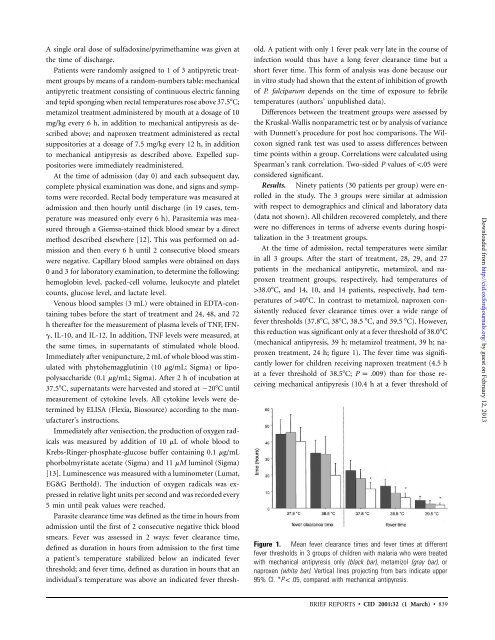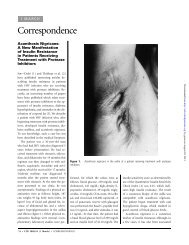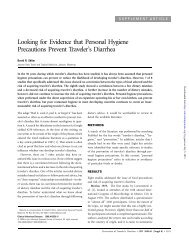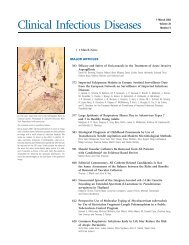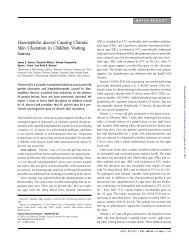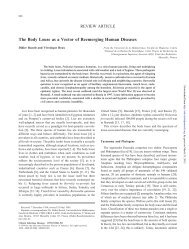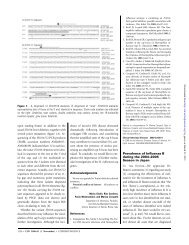Effect of Antipyretic Drugs in Children with Malaria - Clinical ...
Effect of Antipyretic Drugs in Children with Malaria - Clinical ...
Effect of Antipyretic Drugs in Children with Malaria - Clinical ...
You also want an ePaper? Increase the reach of your titles
YUMPU automatically turns print PDFs into web optimized ePapers that Google loves.
A s<strong>in</strong>gle oral dose <strong>of</strong> sulfadox<strong>in</strong>e/pyrimetham<strong>in</strong>e was given at<br />
the time <strong>of</strong> discharge.<br />
Patients were randomly assigned to 1 <strong>of</strong> 3 antipyretic treatment<br />
groups by means <strong>of</strong> a random-numbers table: mechanical<br />
antipyretic treatment consist<strong>in</strong>g <strong>of</strong> cont<strong>in</strong>uous electric fann<strong>in</strong>g<br />
and tepid spong<strong>in</strong>g when rectal temperatures rose above 37.5�C;<br />
metamizol treatment adm<strong>in</strong>istered by mouth at a dosage <strong>of</strong> 10<br />
mg/kg every 6 h, <strong>in</strong> addition to mechanical antipyresis as described<br />
above; and naproxen treatment adm<strong>in</strong>istered as rectal<br />
suppositories at a dosage <strong>of</strong> 7.5 mg/kg every 12 h, <strong>in</strong> addition<br />
to mechanical antipyresis as described above. Expelled suppositories<br />
were immediately readm<strong>in</strong>istered.<br />
At the time <strong>of</strong> admission (day 0) and each subsequent day,<br />
complete physical exam<strong>in</strong>ation was done, and signs and symptoms<br />
were recorded. Rectal body temperature was measured at<br />
admission and then hourly until discharge (<strong>in</strong> 19 cases, temperature<br />
was measured only every 6 h). Parasitemia was measured<br />
through a Giemsa-sta<strong>in</strong>ed thick blood smear by a direct<br />
method described elsewhere [12]. This was performed on admission<br />
and then every 6 h until 2 consecutive blood smears<br />
were negative. Capillary blood samples were obta<strong>in</strong>ed on days<br />
0 and 3 for laboratory exam<strong>in</strong>ation, to determ<strong>in</strong>e the follow<strong>in</strong>g:<br />
hemoglob<strong>in</strong> level, packed-cell volume, leukocyte and platelet<br />
counts, glucose level, and lactate level.<br />
Venous blood samples (3 mL) were obta<strong>in</strong>ed <strong>in</strong> EDTA-conta<strong>in</strong><strong>in</strong>g<br />
tubes before the start <strong>of</strong> treatment and 24, 48, and 72<br />
h thereafter for the measurement <strong>of</strong> plasma levels <strong>of</strong> TNF, IFNg,<br />
IL-10, and IL-12. In addition, TNF levels were measured, at<br />
the same times, <strong>in</strong> supernatants <strong>of</strong> stimulated whole blood.<br />
Immediately after venipuncture, 2 mL <strong>of</strong> whole blood was stimulated<br />
<strong>with</strong> phytohemagglut<strong>in</strong><strong>in</strong> (10 mg/mL; Sigma) or lipopolysaccharide<br />
(0.1 mg/mL; Sigma). After 2 h <strong>of</strong> <strong>in</strong>cubation at<br />
37.5�C, supernatants were harvested and stored at �20�C until<br />
measurement <strong>of</strong> cytok<strong>in</strong>e levels. All cytok<strong>in</strong>e levels were determ<strong>in</strong>ed<br />
by ELISA (Flexia, Biosource) accord<strong>in</strong>g to the manufacturer’s<br />
<strong>in</strong>structions.<br />
Immediately after venisection, the production <strong>of</strong> oxygen radicals<br />
was measured by addition <strong>of</strong> 10 mL <strong>of</strong> whole blood to<br />
Krebs-R<strong>in</strong>ger-phosphate-glucose buffer conta<strong>in</strong><strong>in</strong>g 0.1 mg/mL<br />
phorbolmyristate acetate (Sigma) and 11 mM lum<strong>in</strong>ol (Sigma)<br />
[13]. Lum<strong>in</strong>escence was measured <strong>with</strong> a lum<strong>in</strong>ometer (Lumat,<br />
EG&G Berthold). The <strong>in</strong>duction <strong>of</strong> oxygen radicals was expressed<br />
<strong>in</strong> relative light units per second and was recorded every<br />
5 m<strong>in</strong> until peak values were reached.<br />
Parasite clearance time was def<strong>in</strong>ed as the time <strong>in</strong> hours from<br />
admission until the first <strong>of</strong> 2 consecutive negative thick blood<br />
smears. Fever was assessed <strong>in</strong> 2 ways: fever clearance time,<br />
def<strong>in</strong>ed as duration <strong>in</strong> hours from admission to the first time<br />
a patient’s temperature stabilized below an <strong>in</strong>dicated fever<br />
threshold; and fever time, def<strong>in</strong>ed as duration <strong>in</strong> hours that an<br />
<strong>in</strong>dividual’s temperature was above an <strong>in</strong>dicated fever thresh-<br />
old. A patient <strong>with</strong> only 1 fever peak very late <strong>in</strong> the course <strong>of</strong><br />
<strong>in</strong>fection would thus have a long fever clearance time but a<br />
short fever time. This form <strong>of</strong> analysis was done because our<br />
<strong>in</strong> vitro study had shown that the extent <strong>of</strong> <strong>in</strong>hibition <strong>of</strong> growth<br />
<strong>of</strong> P. falciparum depends on the time <strong>of</strong> exposure to febrile<br />
temperatures (authors’ unpublished data).<br />
Differences between the treatment groups were assessed by<br />
the Kruskal-Wallis nonparametric test or by analysis <strong>of</strong> variance<br />
<strong>with</strong> Dunnett’s procedure for post hoc comparisons. The Wilcoxon<br />
signed rank test was used to assess differences between<br />
time po<strong>in</strong>ts <strong>with</strong><strong>in</strong> a group. Correlations were calculated us<strong>in</strong>g<br />
Spearman’s rank correlation. Two-sided P values <strong>of</strong> !.05 were<br />
considered significant.<br />
Results. N<strong>in</strong>ety patients (30 patients per group) were enrolled<br />
<strong>in</strong> the study. The 3 groups were similar at admission<br />
<strong>with</strong> respect to demographics and cl<strong>in</strong>ical and laboratory data<br />
(data not shown). All children recovered completely, and there<br />
were no differences <strong>in</strong> terms <strong>of</strong> adverse events dur<strong>in</strong>g hospitalization<br />
<strong>in</strong> the 3 treatment groups.<br />
At the time <strong>of</strong> admission, rectal temperatures were similar<br />
<strong>in</strong> all 3 groups. After the start <strong>of</strong> treatment, 28, 29, and 27<br />
patients <strong>in</strong> the mechanical antipyretic, metamizol, and naproxen<br />
treatment groups, respectively, had temperatures <strong>of</strong><br />
138.0�C, and 14, 10, and 14 patients, respectively, had temperatures<br />
<strong>of</strong> 140�C. In contrast to metamizol, naproxen consistently<br />
reduced fever clearance times over a wide range <strong>of</strong><br />
fever thresholds (37.8�C, 38�C, 38.5 �C, and 39.5 �C). However,<br />
this reduction was significant only at a fever threshold <strong>of</strong> 38.0�C<br />
(mechanical antipyresis, 39 h; metamizol treatment, 39 h; naproxen<br />
treatment, 24 h; figure 1). The fever time was significantly<br />
lower for children receiv<strong>in</strong>g naproxen treatment (4.5 h<br />
at a fever threshold <strong>of</strong> 38.5�C; P p .009)<br />
than for those receiv<strong>in</strong>g<br />
mechanical antipyresis (10.4 h at a fever threshold <strong>of</strong><br />
Figure 1. Mean fever clearance times and fever times at different<br />
fever thresholds <strong>in</strong> 3 groups <strong>of</strong> children <strong>with</strong> malaria who were treated<br />
<strong>with</strong> mechanical antipyresis only (black bar), metamizol (gray bar), or<br />
naproxen (white bar). Vertical l<strong>in</strong>es project<strong>in</strong>g from bars <strong>in</strong>dicate upper<br />
95% CI. * P ! .05,<br />
compared <strong>with</strong> mechanical antipyresis.<br />
BRIEF REPORTS • CID 2001:32 (1 March) • 839<br />
Downloaded from<br />
http://cid.oxfordjournals.org/ by guest on February 12, 2013


